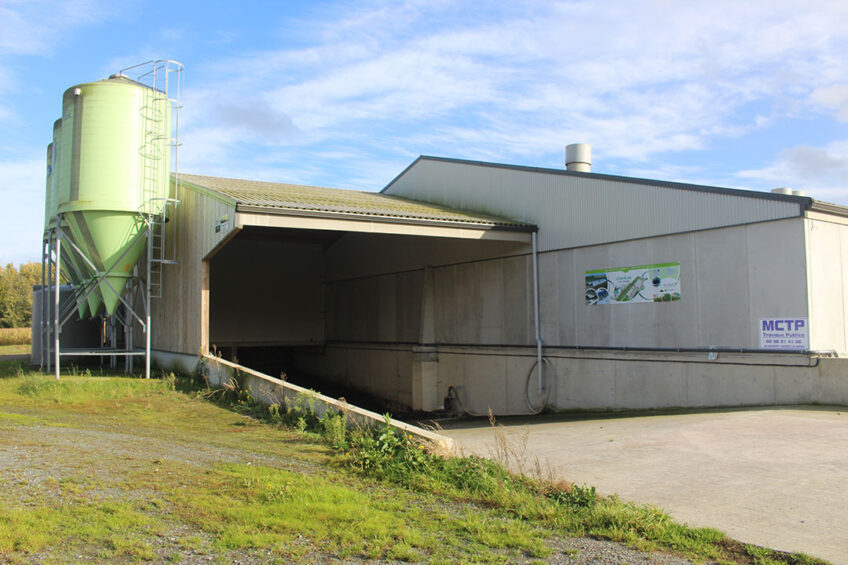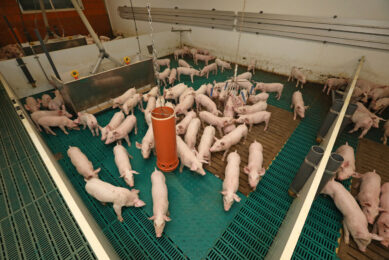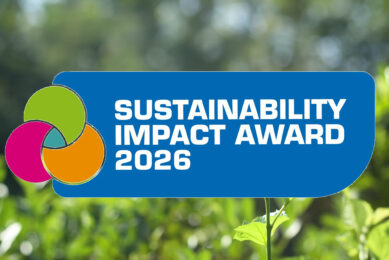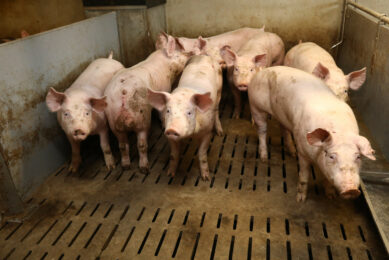Farm visit: An ‘ESF’ station for grow-finishers

Individual precision feeding for sows has been affordable and doable for decades. For finisher pigs, something similar has always been possible too, theoretically; yet the costs and investments somehow never seemed to be outweighed by the benefits. Until 2021, that is. Finisher feeding is about to make the step too – as can be seen in Brittany, France.
Pig 1070016581 understands well how the feed station works. All he needs to do is follow the yellow light. He pushes through the open door and walks across the floor, towards the light. That’s where the trough is. Mashed particles start falling down, and so does fresh water, so in front of him a wet substance appears. He can hear the others around him and can even see them through the holes on the side, but they leave him alone while he starts munching.
The above paragraph probably raises a lot of questions. What is this all about? How do we know pig 1070016581 is male? What is the light all about? How come the pig seems to have a number? And where are we?
Frédéric Baudet (41) has farm Earl de Grand Clos inLa Malhoure, Brittany, France. It is a 2-site farrow-to-finish farm, consisting of one site with 430 sows and a second site with finishers about 2 km away. That facility, which is about 5 years old, has a capacity of 2,000 finishers. At the grow-finisher site, the animals receive three different types of feed. The pigs are sent to slaughter at Cooperl in nearby Lamballe at a weight of roughly 125–130 kg.
To start with the last question – this takes place at the finishing pig site of Earl du Grand Clos near the village La Malhoure, close to Lamballe, Brittany, France. Pig producer Frédéric Baudet, age 41, producing for France’s largest cooperative Cooperl, owns a farrow-to-finish farm there. The farm consists of a sow facility with 430 sows and a grow-finisher site 2 km down the road for 2,000 finishers altogether.
Interested in trying new things and hoping to always improve productivity, Baudet is one of the farmers who was keen to try the Selfifeeder GFI, one of the latest additions to the portfolio of French livestock equipment company Asserva. “GFI” is short for grow-finishers. There is also a Selfifeeder GES, with the GES referring to “gestation”. That design will ring a bell for most; it is Asserva’s version of an Electronic Sow Feeding (ESF) station.
So basically what can be found in Baudet’s finishing site is an “ESF” station, but for grow-finishing pigs, with built-in weighing mechanism. And with that, a new chapter opens up in the development of swine production. No longer are finisher pigs anonymous members of a batch; they have an identity and can be treated according to specific requirements. And that comes with ear tags.

Technology to individualise pig feeding
Truth be told, the technology has been there for quite some time. ESF technology has shown that it is perfectly possible to feed swine according to their individual needs – the question was why do it for grow-finisher pigs? After all, sows generally stay on-farm long enough to cover the investment and effort to provide ear tags. But grow-finishers generally disappear from a farm within a few months.
There are 3 reasons it is timely that the development has now begun, explains Dr Audrey Gloux, R&D project manager at Asserva. She has been closely monitoring the performance results of the new type finisher feeding stations and has frequently visited the Baudet facility as well.

The first reason relates to reducing the feed cost during the grow-finisher period. Feeding for a specific nutritional need also translates into more targeted feed costs. As finishing feed is normally responsible for between 50% and 70% of the feed costs of a swine farm, it is a place where easy gains can be made.
The second reason is an environmental one. As all the pigs are normally on the same diet, feed is formulated so that even the smallest pigs will reach slaughter weight. This means that a lot of pigs will receive and eat more than they need – and thus also excrete more phosphorus and nitrogen. To address that, Dr Gloux explains, multiphase feeding has been developed over the years, which already makes a difference. But what if feed could be supplied on the basis of the weight and further information of the individual animal? It would certainly help reduce emissions – an issue that has attracted a lot of attention in France of late. Many solutions would like to be included in a special list authorities have defined to reduce emissions.
And thirdly, she explains, if feed producers – or consumers – want a better understanding of where the pigs came from and what happened during their lives, it would be possible to backtrack that using the data gathered by the individual feeding station.

Changing the balance
All in all, these factors change the balance of the investment decision about RFID ear tags for finisher pigs. Prices of the tags have come down in recent years and they can be re-used as well; the slaughterhouse can simply remove and decontaminate them.
Heavy ear tags
The system is able to distinguish between entire males, castrates and females and to apply a feed curve for each of them. At Earl de Grand Clos, 3 different types of feeds are used, a grower ration and 2 finisher rations, both consisting of a mixture of wheat, barley, rapeseed, triticale, sunflower and bakery by-products in different proportions. The diets are supplied to the individual feeding station, then the feeder itself provides just enough of the required feed type for that specific animal on the basis of the pig weight it measures in the feeder plus the data provided through the ear tag.
On the Baudet farm, Allflex ear tags are being used at a cost of roughly € 1 each. These are relatively heavy ear tags, which is why they are not added to the pigs’ ears straight after birth. Rather, they are applied just before the pigs are transferred from weaning to the grow-finisher barn at around 25 kg (75–80 days of age).
Ear tags in practice
Just like with ESF stations, the RFID tags communicate with the individual feeding station, so the algorithm determines which type and ration a pig will receive. Dr Gloux explains, “For each pig the ‘day’ begins at a different moment of the day. So the moment that a pig has new credits for rations is different for each pig. That way it will not be very busy at one moment of the day. Plus it allows us to have up to 40 grow-finisher pigs in a pen for one station.”

It is typical in France to put approximately 15 pigs per finisher pen, irrespective of them being fed liquid or dry feed. At Earl du Grand Clos, to accommodate groups of about 40 pigs in restricted feeding conditions, the walls between 3 compartments were partly removed and the individual feeder placed there. That way, the same space per finisher pig (0.7 m2) could still be guaranteed.
Earlier trials, held in Earl de Grand Clos, had already shown a significant difference compared to the conventional system. Compared to the Earl de Grand Clos average expressed in the annual French GTE* report in 2020, feed conversion ratio was lower, at 2.37 vs 2.45. Average daily gain was observed to be roughly identical, at 873 g (GTE) vs 872 g (new feeder station). Emission levels expressed in N excreted per kg/pig was 4.3, which is 7% lower than the average of the farm.

Homogeneity
The figures for average daily gain as well as the lower emission levels are all related to the fact that the pigs raised in the individual feeder are more homogenous when they are sent to slaughter. Valentin Bouvier, export manager at Asserva, explains: “Because every pig gets the ration it needs now, what you’ll see is that we slow down the very fast growing having an ad libitum feeding behaviour with conventional feeders. They would normally be fatty pigs anyway. So the first pigs would go to the slaughterhouse a little bit later compared to conventional feeders. But the biggest gain is that the slow ones grow faster and the end is more uniform.”
Frédéric Baudet confirms the gain in homogeneity. He says, “There is 7% less light pigs at the end of the fattening period compared to traditional feeders.”
Animal welfare
Baudet, who had two Selfifeeder GFI stations placed in his pig house in 2020, confirms the improved feed efficiency and also points to animal welfare; he observed the animals got used to the system very quickly and were not stressed by it.
He continues, “The software provides interesting data such as the mean and individual live weight and average daily gain of pigs. Those data have a huge interest for the follow-up of the fattening phase, helping the animal caretaker to anticipate some diseases on specific animals but also to identify another source of perturbation such as water flow.”
Last but not least, Baudet points to robustness as many pig innovations may look good at a trade show but may not always perform well in the rough environment of a pig farm. The equipment for finisher pigs passes the test, he says. “The cleaning phase is as easy as with traditional feeders, and the equipment is very robust.”
All in all, he’s ready to further invest in individual finisher feeding equipment. “That way I will be ready for the big precision feeding transition.”

Once pig 1070016581 is finished with his meal, he looks up. Sometimes there’s more feed coming. Not this time though. After a while he gives up and walks his way backwards, over the wobbly floor and through the flapping doors again. As soon as he steps outside, his pen mates are waiting for him. The next sneaks in, heading for the yellow light.
* GTE is short for “Gestion Technique Economique”. This is the French system to evaluate the technical and economical performance of a farm, in this case dedicated to grow-finisher pigs.













